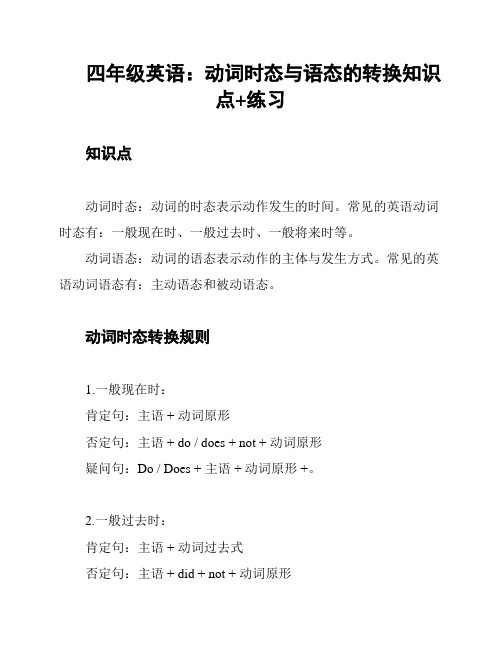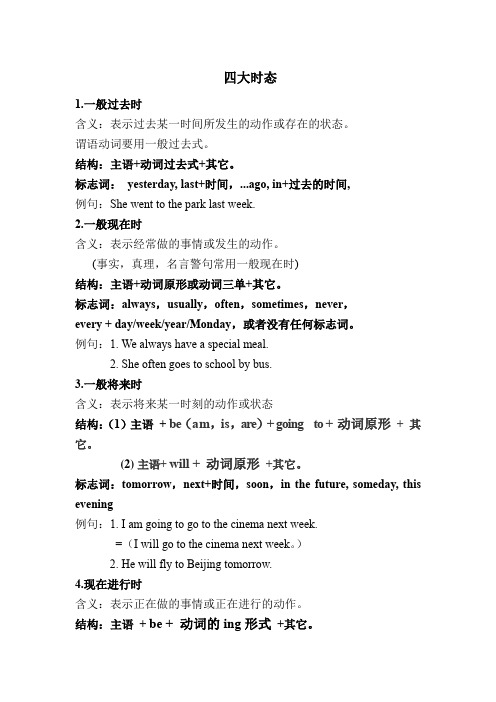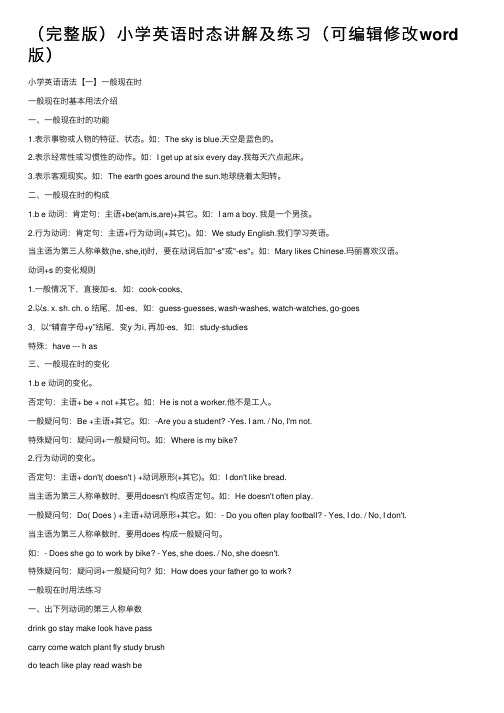小学英语句型转换和时态讲解与练习
小学六年级英语语法四大时态句式转换

四大时态复习1. 一般现在时1一般现在时的构成肯定句☆be动词:主语+beam,is,are+其它;如:I am a boy.我是一个男孩;☆行为动词:主语+行为动词+其它;如:We study English.我们学习英语;☆当主语为第三人称单数he, she,it时,要在动词后加"-s"或"-es";如:Mary likes Chinese. 玛丽喜欢汉语;2一般现在时的变化☆. be动词的变化;否定句:主语+ be + not +其它;如:He is not a worker.他不是工人;一般疑问句:Be +主语+其它; 如:-Are you a student -Yes. I am. / No, I'm not.特殊疑问句:疑问词+一般疑问句;如:Where is my bike☆.行为动词的变化;否定句:主语+ don't doesn't +动词原形+其它;如:I don't like bread.当主语为第三人称单数时,要用doesn't构成否定句;如:He doesn't often play.一般疑问句:Do Does +主语+动词原形+其它;如:- Do you often play football- Yes, I do. / No, I don't.当主语为第三人称单数时,要用does构成一般疑问句;如:- Does she go to work by bike - Yes, she does. / No, she doesn't.特殊疑问句:疑问词+一般疑问句;如:How does your father go to work 动词+s的变化规则1.一般情况下,直接加-s,如:cook-cooks, milk-milks2.以s. x. sh. ch. o结尾,加-es,如:guess-guesses, wash-washes, watch-watches, go-goes 3.以“辅音字母+y”结尾,变y为i, 再加-es,如:study-studies2.现在进行时(1)一般现在时的构成:beam,is, are+ 动词的ing形式;如:I am reading. 我正在读书(2)现在进行时的否定句在be后加not,即beam,is, are + not + 动词的ing形式;如:She is not doing her homework now. 她现在没有做作业;(3)现在进行时的一般疑问句把be动词调到句首,即Beam,is, are + 人+ 动词ing形式;如:Are you drinking milk now 你现在在喝牛奶吗(4)现在进行时的特殊疑问的基本结构为:疑问词+ be + 人+ 动词ing如:Where are you going 你现在去哪但who当主语时其结构为:Who + be + 动词ing如:Who is talking to you 谁在和你说话动词加ing的变化规则1.一般情况下,直接加ing,如:cook-cooking2.以不发音的e结尾,去e加ing,如:make-making, taste-tasting3.如果末尾是一个元音字母和一个辅音字母,双写末尾的辅音字母,再加ing,如:run-running, stop-stopping3.一般将来时1一般将来时基本结构:①be going to + do动词原形;②will+ do动词原形.2否定句:在be动词am, is, are后加not或情态动词will后加not成won’t;结构为:beam, is, are + not + 动词原形will not + 动词原形will not = won’t例如:①I’m going to have a picnic this afternoon.→I’m not going to have a picnic this afternoon.②I will go shopping this weekend.→I will not go shopping this weekend.= I won’t go shopping this weekend.3一般疑问句:be或will提到句首,some改为any, and改为or,第一二人称互换;例如:①We are going to go on an outing this weekend.→Are you going to go on an outing this weekend②I will play football tomorrow afternoon.→Will you play football tomorrow afternoon4特殊疑问句①问人用Who例如:I’m going to New York soon. →Who’s going to New York soon.②问干什么用What …do.例如:My father is going to watch a race with me this afternoon.→What is your father going to do with you this afternoon.③问什么时候用When.例如:She’s going to go to bed at nine. →When is she going to bed4.一般过去时1.肯定句be动词在一般过去时中的变化:☆am 和is在一般过去时中变为was;was not=wasn’t☆are在一般过去时中变为were;were not=weren’t行为动词在一般过去时的句子中要变成过去式一般是在句子后面加ed(2)否定句:be动词变成was notwasn’t 或were not weren’t如:He wasn’t a teacher two years ago.didn’t +动词原形如:Jim didn’t go home yesterday.(3)一般疑问句有be动词的一般疑问句把was或were调到句首;如:Were you a teacher two years ago句中没有be动词的一般过去时的句子,在句首加did,句子中的动词过去式变回原形;如:Did Jim go home yesterday4特殊疑问句:①疑问词+did+主语+动词原形如:What did Jim do yesterday②疑问词是who时:疑问词+动词过去式如:Who went to home yesterday动词过去式变化规则:☆.一般在动词末尾加-ed,如:pull-pulled, cook-cooked☆.结尾是e加d,如:taste-tasted☆.末尾只有一个元音字母和一个辅音字母的重读闭音节,应双写末尾的辅音字母, 再加-ed,如:stop-stopped☆.以“辅音字母+y”结尾的,变y为i, 再加-ed,如:study-studied☆.不规则动词过去式:am,is-was, are-were, do-did, see-saw, say-said, give-gave, get-got, go-went, come-came, have-had, eat-ate, take-took,run-ran, sing-sang, put-put, make-made, read-read, write-wrote, draw-drew, drink-drank, fly-flew, ride-rode,speak-spoke, sweep-swept, swim-swam, sit-sat随堂练习一、写出下列动词的第三人称单数drink ________ go _______ stay ________ make ________ look _________ have_______ pass_______ carry ____ come________ watch______ plant_______ fly ________study_______ brush________ do_________ teach_______二、按照要求改写句子1. Daniel watches TV every evening.改为否定句___________________________________________________2. I do my homework every day.改为一般疑问句,作否定回答________________________________________________________3. She likes milk.改为一般疑问句,作肯定回答___________________________4. I like taking photos in the park.对划线部分提问________________________________________________________5. John comes from Canada.对划线部分提问___________________________________________________三.写出下列动词的现在分词:play________ run__________ swim _________make__________ go_________ like________ write________ _ski___________ read________ have_________ sing ________ dance_________ put_________ see________ buy _________ love____________ live_______ take_________ come ________ get_________ stop_________ sit ________ begin________ shop___________四、句型转换:1. They are doing housework .改成否定句_____________________________________________________________2.The students are cleaning the classroom . 改一般疑问句并作肯定和否定回答__________________________________________________________________________________________________________________________________3.I’m playing the football in the playground .对划线部分进行提问_________________________________________________________________4.Tom is reading books in his study . 对划线部分进行提问_________________________________________________________________五.填空;1. 我打算明天和朋友去野炊;I_____ _______ _________ have a picnic with my friends.I ________ have a picnic with my friends.2. 下个星期一你打算去干嘛我想去打篮球;What ________ ________ _________ _________ _________ next Monday I _______ ______ _____ play basketball.What _________ you do next Monday I ________ play basketball.3. 你妈妈这个周末去购物吗是,她要去买一些水果;_____ your mother _______ ________ go shopping this ___________ Yes, she _________.She ______ ________ __________ buy some fruit.4. 你们打算什么时候见面;What time _______ you _________ __________ meet5. Nancy is going to go camping.改否定Nancy ________ going to go camping.6. I’ll go and join them.改否定I _______ go ______ join them.7. I’m going to get up at 6:30 tomorrow.改一般疑问句________ _______ ________ to get up at 6:30 tomorrow8. We will meet at the bus stop at 10:30.改一般疑问句_______ ________ meet at the bus stop at 10:30.9. She is going to listen to music after school.对划线部分提问________ _______ she ________ ________ _________ after school10. My father and mother are going to see a play the day after tomorrow.对划线部分提问_________ _________ going to see a play the day after tomorrow.七.写出下列动词的过去式fly_______ plant________ are ________ drink_________ play_______ go________make ________ does_________ dance________ worry________ ask _____ taste_________ eat__________ draw________ put ______ throw________ kick_________ pass_______do ________八、句型转换1. It was exciting.否定句:________________________________________________一般疑问句:____________________________________________肯、否定回答:__________________________________________2. All the students were very excited.否定句:________________________________________________一般疑问句:____________________________________________肯、否定回答:__________________________________________3. They were in his pocket.否定句:________________________________________________一般疑问句:____________________________________________肯、否定回答:__________________________________________4. Su Hai took some photos at the Sports day.否定句:________________________________________________一般疑问句:____________________________________________肯、否定回答:__________________________________________5. Nancy went to school early.否定句:________________________________________________一般疑问句:____________________________________________肯、否定回答:__________________________________________6. We sang some English songs.否定句:________________________________________________一般疑问句:____________________________________________肯、否定回答:__________________________________________。
四年级英语:动词时态与语态的转换知识点+练习

四年级英语:动词时态与语态的转换知识点+练习知识点动词时态:动词的时态表示动作发生的时间。
常见的英语动词时态有:一般现在时、一般过去时、一般将来时等。
动词语态:动词的语态表示动作的主体与发生方式。
常见的英语动词语态有:主动语态和被动语态。
动词时态转换规则1.一般现在时:肯定句:主语 + 动词原形否定句:主语 + do / does + not + 动词原形疑问句:Do / Does + 主语 + 动词原形 +。
2.一般过去时:肯定句:主语 + 动词过去式否定句:主语 + did + not + 动词原形疑问句:Did + 主语 + 动词原形 +。
3.一般将来时:肯定句:主语 + will + 动词原形否定句:主语 + will + not + 动词原形疑问句:Will + 主语 + 动词原形 +。
其他时态的转换规则可以参考相关教材。
动词语态转换规则1.主动语态:肯定句:主语 + 动词原形 / 动词时态否定句:主语 + do / does / did + not + 动词原形 / 动词时态疑问句:Do / Does / Did + 主语 + 动词原形 / 动词时态 +。
2.被动语态:肯定句:主语 + am / is / are / was / were + 过去分词否定句:主语 + am / is / are / was / were + not + 过去分词疑问句:Am / Is / Are / Was / Were + 主语 + 过去分词 +。
练题1.把下列句子改成一般现在时的否定句:I like apples。
-。
I do not like apples.___ to music。
-。
She does not listen to music.2.把下列句子改成一般过去时的疑问句:___。
-。
Did they play basketball?___。
-。
Did I watch a movie yesterday。
小学英语句型转换及时态讲解及练习

合用文档否认句:be 动词( am、 is 、 are ) +not 、神态动词 can+ not 、助动词( do、 does) + not怎样将一个必定的陈说句改为否认句:1、看句中有无be 动词,若有,直接在 be 动词后 + not 。
2、看句中有无神态动词,若有,直接在神态动词后+ not 。
3、如上述二者都没有,就应用助动词+ not 。
分四个步骤:(1)必定陈说句中原来是没有助动词的,要加上去,地点在主语(某人或某物)后,动词前。
(2)确立助动词用 do、does,依据句中动词,动词是原形的助动词就用 do,动词是第三人称单数的助动词就用 does,(3)在助动词后加 not 。
(4)原句中动词若是发生变化就要恢复成原形。
重申一点,有 some的要考虑能否要用 any 。
1. I amTom.______________________________2.He isnine.______________________________3.They arepupils.______________________________4.I can fly a kite.______________________________5.He can make atoy.______________________________6.You must go homenow.______________________________7.I likeJinan.8.He likesswimming.9.He hasmany books. 10.He hassome books.11.There is a pen on thedesk.12.There are some water in theglass.______________________________13.You have got some books.___________________________________14. You have somebooks.15.He has gotsome apples.16. He has some apples._________________________________________ 17.I like to watchTV.______ .18.Xiao Fang and I go to thelibrary everSaturday..19.Tim swimsvery well.___________.20.Mr. Smith has many books aboutthe cars..21.I want to play withmy friends..22.We feel coldtoday._____________ .23.Bob reads Englisheveryday..24.We do our homeworkat school..合用文档25.Mr. White hastwo houses..一般疑问句怎样将一个必定的陈说句改为一般疑问句:1、看句中有无 be 动词,若有,把 be 动词提到句首即可。
小学英语:时态+句型转换

四大时态1.一般过去时含义:表示过去某一时间所发生的动作或存在的状态。
谓语动词要用一般过去式。
结构:主语+动词过去式+其它。
标志词:yesterday, last+时间,...ago, in+过去的时间,例句:She went to the park last week.2.一般现在时含义:表示经常做的事情或发生的动作。
(事实,真理,名言警句常用一般现在时)结构:主语+动词原形或动词三单+其它。
标志词:always,usually,often,sometimes,never,every + day/week/year/Monday,或者没有任何标志词。
例句:1. We always have a special meal.2. She often goes to school by bus.3.一般将来时含义:表示将来某一时刻的动作或状态结构:(1)主语+ be(am,is,are)+ going to + 动词原形+ 其它。
(2)主语+ will + 动词原形+其它。
标志词:tomorrow,next+时间,soon,in the future, someday, this evening例句:1. I am going to go to the cinema next week.=(I will go to the cinema next week。
)2. He will fly to Beijing tomorrow.4.现在进行时含义:表示正在做的事情或正在进行的动作。
结构:主语+ be + 动词的ing形式+其它。
标志词:now,look,listen, in this picture/photo例句:Look, the bird is flying in the sky.六、句型转换一、肯定句变一般疑问句1.先找三类词,be(am,is,are)情态动词can,could,will, would, shouldhave got / has got如果有这三类词,先把把这些词放在句首,句号改成问号,其余照抄;(第一人称变成第二人称(I变you,we变you),some改成any)2. 如果句子中没有以上词,要在句首加助动词Do,Does,Did。
(完整版)小学英语时态讲解及练习(可编辑修改word版)

(完整版)⼩学英语时态讲解及练习(可编辑修改word 版)⼩学英语语法【⼀】⼀般现在时⼀般现在时基本⽤法介绍⼀、⼀般现在时的功能1.表⽰事物或⼈物的特征、状态。
如:The sky is blue.天空是蓝⾊的。
2.表⽰经常性或习惯性的动作。
如:I get up at six every day.我每天六点起床。
3.表⽰客观现实。
如:The earth goes around the sun.地球绕着太阳转。
⼆、⼀般现在时的构成1.b e 动词:肯定句:主语+be(am,is,are)+其它。
如:I am a boy. 我是⼀个男孩。
2.⾏为动词:肯定句:主语+⾏为动词(+其它)。
如:We study English.我们学习英语。
当主语为第三⼈称单数(he, she,it)时,要在动词后加"-s"或"-es"。
如:Mary likes Chinese.玛丽喜欢汉语。
动词+s 的变化规则1.⼀般情况下,直接加-s,如:cook-cooks,2.以s. x. sh. ch. o 结尾,加-es,如:guess-guesses, wash-washes, watch-watches, go-goes3.以“辅⾳字母+y”结尾,变y 为i, 再加-es,如:study-studies特殊:have --- h as三、⼀般现在时的变化1.b e 动词的变化。
否定句:主语+ be + not +其它。
如:He is not a worker.他不是⼯⼈。
⼀般疑问句:Be +主语+其它。
如:-Are you a student? -Yes. I am. / No, I'm not.特殊疑问句:疑问词+⼀般疑问句。
如:Where is my bike?2.⾏为动词的变化。
否定句:主语+ don't( doesn't ) +动词原形(+其它)。
如:I don't like bread.当主语为第三⼈称单数时,要⽤doesn't 构成否定句。
小学英语时态讲解及练习可直接.docx

小学英语语法【一】一般现在时一般现在时基本用法介绍一、一般现在时的功能1.表示事物或人物的特征、状态。
如:The sky is blue.天空是蓝色的。
2.表示经常性或习惯性的动作。
如:I get up at six every day.我每天六点起床。
3.表示客观现实。
如: The earth goes around the sun.地球绕着太阳转。
一般现在时用法练习一、出下列动词的第三人称单数drink ________ go _______ stay________ make ________look _________ have_______ pass_______ carry ____ come________ watch______ plant_______fly ________study_______ brush________ do______ teach_______ likeplay read wash be二、用括号内动词的适当形式填空。
1.He often ________(have) dinner at home.2.Daniel and Tommy _______(be) in Class One.3.We _______(not watch) TV on Monday.4.Nick _______(not go) to the zoo on Sunday.5.______ they ________(like) the World Cup?6.What _______they often _______(do) on Saturdays?7._____ your parents _______(read) newspapers every day?8.The girl _______(teach) us English on Sundays.9.She and I ________(take) a walk together every evening.10.There ________(be) some water in the bottle.11.Mike _______(like) cooking.12.They _______(have) the same hobby.13.My aunt _______(look) after her baby carefully.14.You always _______(do) your homework well.15.I _______(be) ill. I’m staying in bed.16.She _______(go) to school from Monday to Friday.17.Liu Tao _______(do) not like PE.18.The child often _______(watch) TV in the evening.19.Su Hai and Su Yang _____(have) eight lessons this term.20. - What day _____(be) it today?-It’s Saturday.三、按照要求改写句子2.I do my homework every day.(改为一般疑问句,作否定回答)_____________________________________________________3.She likes milk.(改为一般疑问句,作肯定回答)__________________________4.Amy likes playing computer games.(改为一般疑问句,作否定回答)___________________________________6.He speaks English very well.(改为否定句)_______________________________________________7.John comes from Canada.(对划线部分提问)_______________________一般现在时练习1. He often(have) dinner at home.2. Daniel and Tommy(be) in Class One.3. We(not watch) TV on Monday.4. Nick(not go) to the zoo on Sunday.5.they(like)the World Cup?6. What they often(do) on Saturdays?7.your parents(read)newspapers every day?8. The girl(teach)us English on Sundays.9. She and I(take) a walk together every evening.10. There(be) some water in the bottle.小学英语语法【二】现在进行时现在进行时1.现在进行时表示现在正在进行或发生的动作,也可表示当前一段时间内的活动或现阶段正在进行的动作。
小学英语语法时态归纳及练习(含答案解析)
英语时态归纳一、一般现在时:标志词:often(经常) sometimes(有时) always(总是) usually(通常) never(从不) every(每一)行为动词词型变化形式:一般现在时动词只有第三人称有词形变化;其他人称(第一人称:I, we;第二人称:you;第三人称复数:they、my friends)动词均用原形。
当主语是第三人称单数时,一般动词在一般现在时句子中的变化规律:1、多数在动词后加s:play—plays like—likes ,2、以s,x,sh,ch,o结尾的动词加es wash–washes catch–catches do–does3、以辅音字母加y结尾,把y改i再加es fly—flies study—studies4、以元音字母加y结尾,直接加s buy – buys5、不规则变化have—has一般现在时基本用法功能1.表示事物或人物的特征、状态。
如:The sky is blue.天空是蓝色的。
2.表示经常性或习惯性的动作。
如:I get up at six every day.我每天六点起床。
3.表示客观现实。
如:The earth goes around the sun.地球绕着太阳转。
The earth is round.构成1. be动词:主语+be(am,is,are)+其它。
如:I am a boy.我是一个男孩。
2.行为动词:主语+行为动词(+其它)。
如:We study English.我们学习英语。
句型肯定句:A.be动词:主语+ be + 其它成分He is a worker.B.行为动词:主语+动词(注意人称变化) +其它成分We like the little cat.否定句:A.be动词:主语+ be + not+其它成分They are not students.B.行为动词:主语+助动词(do/does) + not+动词原形+其它成分We don’t like the little cat.一般疑问句:A.be动词:Am / Is /Are +主语+ 其它成分Are you a teacher? Yes, I am. / No, I am not.Are they students of your school. Yes, they are / No they aren’t.B.行为动词:助动词(Do/Does)+主语+动词原形+ 其它成分Do you like it? Yes, I do. / No. I don’t .Does he(she) like it? Yes, he( she )does. / No, he ( she )doesn’t.特殊疑问句:疑问词+ 一般疑问句A.be动词:How many students are there in your school?B.行为动词:What do you usually do on Sunday?一般现在时动词be和have的变化形式1.动词Be 叫连系动词, 用法:第一人称单数用am,第三人称单数用is,其它人称用are。
小学英语语法及习题 四大基本时态
小学英语语法及习题---四大基本时态一、一般现在时一般现在时基本用法介绍【No. 1】一般现在时的功能1.表示事物或人物的特征、状态。
如:The sky is blue.天空是蓝色的。
2.表示经常性或习惯性的动作。
如:I get up at six every day.我每天六点起床。
3.表示客观现实。
如:The earth goes around the sun.地球绕着太阳转。
一般现在时的构成1. beI am a boy.我是一个男孩。
2.We study English.我们学习英语。
当主语为第三人称单数(he, she,it)时,要在动词后加"-s"或"-es"。
如:Mary likes Chinese.玛丽喜欢汉语。
一般现在时的变化1. be动词的变化。
如:He is not a worker.他不是工人。
如:-Are you a student?-Yes. I am. / No, I'm not.Where is my bike?2.行为动词的变化。
I don't like bread.当主语为第三人称单数时,要用doesn't构成否定句。
如:He doesn't often play.- Do you often play football?- Yes, I do. / No, I don't.当主语为第三人称单数时,要用does构成一般疑问句。
如:- Does she go to work by bike?- Yes, she does. / No, she doesn't.How does your father go to work?动词+s的变化规则1.一般情况下,直接加-s,如:cook-cooks, milk-milks2.以s. x. sh. ch. o结尾,加-es,如:guess-guesses, wash-washes, watch-watches, go-goes3.以“辅音字母+y”结尾,变y为i, 再加-es,如:study-studies一般现在时用法专练:一、写出下列动词的第三人称单数drink ________ go _______ stay ________ make ________look _________ have_______ pass_______ carry ____come________ watch______ plant_______ fly ________study_______ brush________ do_________ teach_______二、用括号内动词的适当形式填空。
小学英语基础时态4种
小学英语基础时态4种一、一般现在时一般现在时基本用法介绍【No. 1】一般现在时的功能1.表示事物或人物的特征、状态。
如:The sky is blue.天空是蓝色的。
2.表示经常性或习惯性的动作。
如:I get up at six every day.我每天六点起床。
3.表示客观现实。
如:The earth goes around the sun.地球绕着太阳转。
一般现在时的构成1. be动词:主语+be(am,is,are)+其它。
如:I am a boy.我是一个男孩。
2.行为动词:主语+行为动词(+其它)。
如:We study English.我们学习英语。
当主语为第三人称单数(he, she,it)时,要在动词后加"-s"或"-es"。
如:Mary likes Chinese.玛丽喜欢汉语。
一般现在时的变化1. be动词的变化。
否定句:主语+ be + not +其它。
如:He is not a worker.他不是工人。
一般疑问句:Be +主语+其它。
如:-Are you a student?-Yes. I am. / No, I'm not.特殊疑问句:疑问词+一般疑问句。
如:Where is my bike?2.行为动词的变化。
否定句:主语+ don't( doesn't ) +动词原形(+其它)。
如:I don't like bread.当主语为第三人称单数时,要用doesn't构成否定句。
如:He doesn't often play.一般疑问句:Do( Does ) +主语+动词原形+其它。
如:- Do you often play football?- Yes, I do. / No, I don't.当主语为第三人称单数时,要用does构成一般疑问句。
如:- Does she go to work by bike?- Yes, she does. / No, she doesn't.特殊疑问句:疑问词+一般疑问句。
小学英语时态精讲及练习
按要求完成句子
1.Do you often play football after school? (肯定 回答)
2. I have many books. (改为否定句) 3. My sister likes peaches.(改为否定句) 4. She lives in a small town near New
小学英语时态
四种时态
一般现在时 现在进行时 将来时 过去时
一般现在时
一般现在时:表示经常性的事情,习惯 性的动作或一般性事实。 时间状语: often 经常, usually通常, always 总是,every day每天, sometimes 有时等。
句子结构:1.主语+is/am/are+其他 2.主语(非单三)+动词原形+其他 3.主语(单三)+动词s或es+其他
work, ( )2.
Wwhoork_B_._Bw__o_rk_s_,
work C. work, English best in
works your class?
speak B. speaks C. speaking
( )3. He often ____C______ the windows .
put-putting, begin-beginning ,swim-swimming, run-running, …
现在进行时
studys_t_u_dy_ing make_m_a_k_ing swim_sw_i_m_ming stop_s_to_p_p_ing come_c_o_m_ing close_c_l_os_i_ng have_h_a_v_ing run_r_u_n_ning drive_d_r_iv_in_g wash_w_a_shing begin—be—ginninwg atch_w_a_tching take—ta—king talk—ta—lking put—pu—tting
- 1、下载文档前请自行甄别文档内容的完整性,平台不提供额外的编辑、内容补充、找答案等附加服务。
- 2、"仅部分预览"的文档,不可在线预览部分如存在完整性等问题,可反馈申请退款(可完整预览的文档不适用该条件!)。
- 3、如文档侵犯您的权益,请联系客服反馈,我们会尽快为您处理(人工客服工作时间:9:00-18:30)。
否定句:be动词(am、is、are)+not、情态动词can+ not、助动词(do、does)+ not如何将一个肯定的陈述句改为否定句:1、看句中有无be动词,如有,直接在be动词后+ not。
2、看句中有无情态动词,如有,直接在情态动词后+ not。
3、如上述二者都没有,就应用助动词+ not。
分四个步骤:(1)肯定陈述句中本来是没有助动词的,要加上去,位置在主语(某人或某物)后,动词前。
(2)确定助动词用do、does,根据句中动词,动词是原形的助动词就用do,动词是第三人称单数的助动词就用does,$(3)在助动词后加not。
(4)原句中动词假如发生变化就要恢复成原形。
强调一点,有some的要考虑是否要用any。
1.I am Tom. ______________________________2.He is nine. ______________________________3.They are4.I can fly a kite. ______________________________5.He can make atoy. ______________________________6.You must go home7.I like Jinan.8.'9.He likes swimming.10.He has many books.11.He has some books.12.There is a pen on the desk.13.There are some water in theglass. ______________________________14.You have got some books.___________________________________15.You have some books.16.He has got some apples.17.He has some apples._________________________________________18.I like to watch TV. ______ .19.20.Xiao Fang and I go to the libraryeverSaturday. .21.Tim swims verywell. ___________ .22.Mr. Smith has many books about thecars. .23.I want to play with my friends. .24.We feel coldtoday. _____________ .25.Bob reads English everyday. .26.We do our homework atschool. .27.Mr. White has two houses. .一般疑问句如何将一个肯定的陈述句改为一般疑问句:,1、看句中有无be动词,如有,把be动词提到句首即可。
2、看句中有无情态动词,如有,把情态动词提到句首即可。
3、如上述二者都没有,就应把助动提到句首。
分四个步骤:(1)肯定陈述句中本来是没有助动词的,要加上去,位置在主语(某人或某物)后,动词前。
(2)确定助动词用do还是does,根据句中动词,动词是原形的助动词就用do,动词是第三人称单数的助动词就用does(3)把助动词后提到句首。
(4)原句中动词假如发生变化就要恢复成原形。
强调一点,有some的要考虑是否要用any。
28.I am Tom. ______________________________29.He is nine. ______________________________30.,31.They are32.I can fly a kite. ______________________________33.He can make atoy. ______________________________34.You must go home35.I like Jinan.36.He likes swimming.37.He has many books.38.He has some books.39.There is a pen on the desk.40.There are some water in theglass. ______________________________41.、44.He has got some apples.45.He has some apples._________________________________________46.I like to watch TV. ______ .47.Xiao Fang and I go to the libraryeverSaturday. .48.Tim swims verywell. ___________ .49.Mr. Smith has many books about thecars. .50.I want to play with my friends. .51.We feel coldtoday. _____________ .52.*53.Bob reads English everyday. .54.We do our homework atschool. .55.Mr. White has two houses. .特殊疑问句表示疑问,有疑问词(在开头),回答有很多种可能。
常用疑问词:一、选择正确的单词填空(who, where, when)is that pretty girl She is my sister.#are Jack and Tom They are behind you.do you go to school I go to school from Monday to Friday.has a beautiful flower John has a beautiful flower.are they They are my parents.is my mother She is in the living room.are you going We are going to the bakery(面包坊).do Jim and Wendy play ball They play ball in the afternoon.does he jog He jogs in the park.are you from I'm from Changchun city.二.用what time, what color, what day, what填空。
|1. A: ______ _______ is it B: It is nine o’clock.2. A: ______ _______ does your mother get upB: My mother gets up at 6:30.3. A: ______ _______ do you go to bed B: I go to bed at 10:00.4. A: ______ _______ do Diana and Fiona have supper B: Diana and Fiona have supper at 18:00.5. A: ______ _______is it B: It is purple.6. A: ______ _______ is the sky B: The sky is blue.7. A: ______ _______ is your coat B: My coat is black.8. A: ______ _______ is the dog B: The dog is white.,9. A: ______ _______ is today B: Today is Monday.10. A: ______ _______ is tomorrow B: Tomorrow is Tuesday.11. A: ______ _______ was yesterday(昨天) B: Yesterday was Sunday.12. A: ______ _______ do you like B: I like red.13. A: ______ is this This is a computer(电脑).14. A: ______ are you doing B: We are playing basketball.15. A: ______ does your mother do B: My mother is a policewoman.16. A: ______ are those B: Those are peppers(辣椒).17. A: ______ is in the box B: A lovely doll is in the box.18. A: ______ is on the table B: The apple is on the table.。
19. A: ______ is in the classroom The blackboard is in the classroom.20. A: ______ ______ ______ B: Mary is hungry.21. A: ______ ______ ______ ______ ______B: My favorite color is pink.22. A: ______ ______ ______ ______ B: Nick is playing table tennis.三、就画线部分提问is my father.are under the tree.often watch TV after dinner.(晚饭后) (提示:饭后强调的是时间问题。
)swims in the swimming pool.(游泳池)。
flies in the sky.often brush my teeth in the evening.likes to play with Bill.'s father plays badminton(羽毛球) every weekend. supermarket is near the school.laptop(笔记本电脑) is on the table.has a pair of earrings(耳环).flowers are in the flower pot(花盆).grandpa took us to the zoo.put the gold fish(金鱼) into the fish tank(鱼缸).[monkey sleeps at night.四.连线:(Match)1. What’s on the chair There is a book in the bag.2. How is your father These are apples.3. What are these I go to school by bus.4. What is in the bag The radio is on the chair.,5. How do you go to school My father is fine.6. How much is it I wash my face in the morning.7. What time is it I have two hands.8. When do you wash your face It is four o’clock.9. How many hands do you have It is 5 RMB(人民币). do you have lunch I have lunch at noon.#句型转换练习:一、按要求完成句子(要求:A:改为一般疑问句B:改为否定句)1. I am a student. →A:B:]2. They are English cars. →A:B:3. This is a pencil-box. →A:B:4. Its name is Polly. →A:B:5. These are my English books. →A:B:6. I know his name. →A:B:】7. Please look after your cat. →A:B:8. There is some money in the purse. →A: B:9. There are many apples on the tree. →A: B:10. You can go to have a look. →A:B:11. Come here, please. →AB:;二、回答句子(A:肯定回答B:否定回答)1. Are you a teacher →A: B:2. Is this your ruler →A: B:3. Are those banana trees →A: B:4. Is there a picture on the wall →A: B:5. Are there any trees on the hill →A: B:6. Can you see a bird in the sky →A: B:7. Do you know Mr Wang →A: B:;三、单复数句变换(把单数的句子变成复数,复数的变成单数):1. Is this your box →:2. There is a boy in the picture. →3. That is his new book. →4. It is a Chinese car. →5. She is a woman worker. →^6. We have many old pictures. →7. Are those English books →8. They are Japanese students. →9. Who are those men over there →10. They are some policemen. →¥四、就划线部分提问:1. Your book is here. →___________ ________ yourbook2. I’m thirteen. →3. Bill is in Class Five. →___________ ________ ______Bill __________is in Row Nine. →___________ ________ ________ she ________5. That’s a map in English. →___________ ___________ in English6. Seven and eight is fifteen. →___________ ___________ seven and eight7. They are boxes →__________ ____________ they8. The woman is Mrs. Read →__________ _____________ the woman、9. Mr. Zhang is at home. →____________ Mr. Zhang flowers are near the window. →___________ ________ the flowersflowers near the window are purple. →_________ _________ are purpleflowers near the window are purple. →____________ are purpleisn’t at school today. →___________ isn’t at school todayare some books under the tree. →_________ _________ under the treeare fifty books on the desk. →______ _____ _____are there on the deskis a child in the tree. →________ ______ ______ are there in the treefather is a doctor. →__________ is ____________ fatheris fine. →___________ is he.is five. →___________ __________ is heapples are green. →_________ __________ are those applesgreen apples are mine. →________ _________ are ________are their shoes. →_____________ ______________ are these23. It’s twelve o’clock now. →_______ __________________ _________now24. Kate is Mr. Green’s daughter. →___________ ____________ is Katelike the pictures in this book. →______ _____you like in this book’s seven ten now. →_______ ________ ______ ______nowLei’s uncle is a policeman. →am Kate’s brother. →~Green is an English teacher. →Sally is their Chinese teacher. →五、把下列句子改为否定疑问句,并作肯定和否定回答.1.I am Chinese. →2.3.I can open the door and get the ball. →4.5.I know his address. →6.7.It’s over the hill. →8.9.10.Miss Gao is an English teacher. →11.12.There’re six people in my family. →13.14.There is some money on the floor.六.按要求改写句子。
